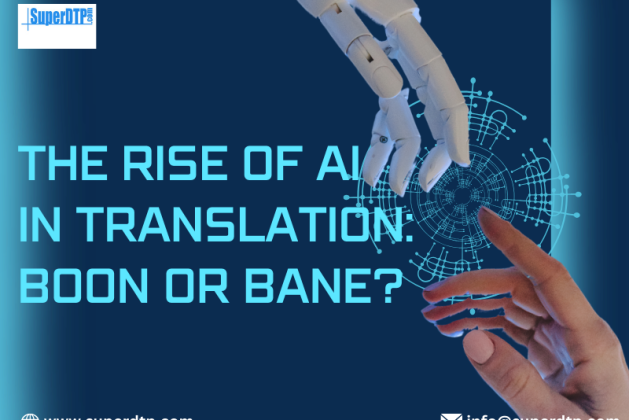The advancement of artificial intelligence and its incorporation into the translation process have been the driving force behind the evolution of the translation industry for a number of years. Machine learning algorithms and neural networks now help us translate texts with surprising precision and speed. Artificial intelligence (AI) is the ability of robots to perceive, synthesize, and deduce information, as opposed to human or animal intelligence. The term “intellect” refers to the capacity for learning, reasoning, generalization, and meaning inference. Artificial intelligence is the fusion of science and technology to create robots capable of doing activities like speech recognition, language translation, and decision-making that require human intelligence and interaction. Artificial intelligence is known to stimulate human intelligence in machines and train them to perform various tasks otherwise designed to be done by humans. The goal of generative AI is to save time for professionals in a variety of fields.
The Evolution of Translation Technology
Technology has, as we all know, always served as a marker for the transition between human eras. This also occurred in the translation industry. The history of translation technology, from its humble origins with paper dictionaries to its sophisticated AI-driven tools of today, is a reflection of broader trends in the language industry and the constant need for translations that are accessible, accurate, and quick. The translation of text from one language to another by machine is known as machine translation. The 1930s saw the earliest discussions of automatic translation, which was over a century ago. That’s when two scientists, working independently of one another, developed new translation machines and took the first steps toward automation.
The use of software tools to make text translation across languages easier is known as translation technology.
Translation technology encompasses:
Computer-assisted translation (CAT) tools
Machine translation (MT) software
Translation management systems (TMS)
Computer-assisted translation tools (CAT):
Software programs designed to assist translators in their day-to-day work are known as CAT tools. CAT tools use databases of previous translations (usually from a specific source language and target language) as well as frequency information, segmentation data, and a wealth of other resources to aid the translation process. They can record the translated text segments for later use in different tasks. They can also automatically segment texts. It was at this point that translation memory began.
Machine translation (MT):
An automatic technique called machine translation generates translated material without the need for human input. It falls into one of three categories: neural (NMT), statistical (SMT), or rule-based (RBMT). Language pairs, subject matter, pre-editing, training data accessibility, and post-editing resources all affect how well an MT produces results.
Translation Management Systems (TMS):
TMS platforms streamline translation project management, supporting multiple languages, real-time collaboration, and integration with computer-assisted translation tools and machine translation. These systems ensure an organized workflow and scalability, facilitating efficient translation project handling.
How AI Has Transformed Translation
Although AI won’t replace human translators anytime soon, it is revolutionizing the translation services sector. It has broad uses and is greatly streamlining the entire process. In practical terms, AI facilitates people’s access to fast and generally accurate translations. For travelers who are traveling the world, this can mean using a translation app like Google Translate, which offers real-time translations for common conversations. By creating language databases using translated text as a basis, artificial intelligence (AI) now speeds up translation. Consequently, virtually anything may be translated by translators using AI, including legal papers, audiovisual files, marketing content, and educational materials.
It’s important to remember, though, that AI is designed to help people translate texts more efficiently. Nevertheless, future translations will be done by humans. Further, when it comes to localization, machine translation often lacks cultural sensitivity. Therefore, a human touch from professional translators is crucial to ensure the texts are culturally appropriate.
Advantages of AI in Translation
Artificial Intelligence (AI) has paved the way in a new era of efficiency and effectiveness in translation services, offering a number of benefits to users and businesses alike.
Efficiency: The capacity of AI to optimize the translation process, resulting in much shorter turnaround times and higher overall productivity, is one of the technology’s most important benefits for translation services. Large text volumes can be quickly analyzed and translated by AI-powered translation technologies, which also automate repetitive operations that would take a long time for human translators.
Cost-effective: By reducing the need for human translators and localization agency specialists, AI-powered translation and localization technologies can help firms save money.
Increased productivity: Businesses can generate more content faster using AI-powered solutions, which helps them stay ahead of the competition.
Challenges and Limitations of AI in Translation
Privacy and Security
AI translation services often require users to input their text for translation. Even when trustworthy businesses take security and privacy seriously, there is always a chance that private or sensitive data could be accidentally revealed. The same privacy issues that have been raised about AI-generated news also apply to AI translation.
Quality Assurance: The Right Keywords for SEO Challenge
Making sure the machine produces the intended result is one of the main problems with AI translations. A customer case we recently had illustrated this point in a way that is quite common. Technically correct terms were used in the text, but the proper SEO keywords were absent.
Lack of localisation
AI translation tools cannot understand a particular region’s local context or languages. For example, dialectal variances or slang may exist that AI algorithms are unable to translate, resulting in misunderstandings.
Conclusion
AI in translation is undeniably a powerful tool that has transformed the way we communicate across languages. While it offers numerous advantages, it also comes with its set of challenges and ethical considerations. As AI technology continues to evolve, it is essential to find a balance between leveraging its benefits and addressing its limitations.
Super DTP Ltd is a specialized desktop publishing agency located in Gabrovo Bulgaria, offering book publishing, multilingual DTP, and E-learning localization services to translation agencies and localization companies worldwide! Check our services at http://www.superdtp.com or contact us at dtp.bulgaria@gmail.com for further details




Leave a comment